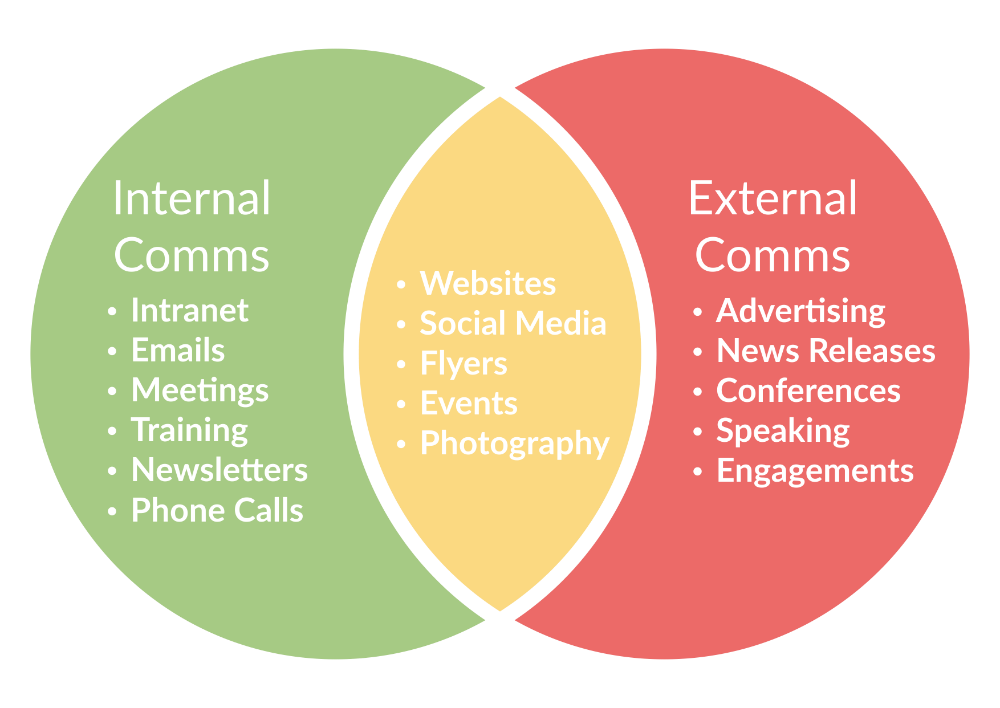Clear and effective communication has always been a key factor in the success of any kind of business communication. When it comes to communication there are two main aspects to consider. Let’s take a look at external communications first. This is all about sending a message across to customers, shareholders and potential customers. Nowadays these are accomplished with many different tools and strategies—from modern disciplines like social media and online marketing, all the way to traditional avenues of advertising.
The second aspect is internal communication, or communicating to employees. The messages can vary from anything as simple as corporate announcements to larger strategic shifts and – increasingly – employee collaboration. As with external communications, the channels through which messages can be sent varies—from chat applications to intranets. Whereas before there was a clear differentiation between the two, there is now a blurring of the lines that needs to be addressed.
The Importance of Building and Maintaining a Brand
You can’t talk about internal and external communication without also touching on the importance of branding in today’s business landscape. We live in a world where access to information is near instantaneous. Any business can get a social media post or website update out that exposes it to a very wide audience. With so many businesses offering the same kinds of services, the key differentiator has been branding—what the business values, what the characteristics are and – ultimately – what the business projects itself as.
If there’s one thing that makes any one particular brand successful, it’s consistency across the board. If a brand touts itself as being family oriented, then its marketing message will often reflect a light-hearted friendliness in its website content and social media posts. More than that, however, it also needs to reflect the same value within the company and among its people. For example, it doesn’t work to project a family-friendly image to the outside world, but then force too many hours on an employee—preventing them from quality time with their family.
The Blurring of Lines Between Internal and External Communications
That’s where communications come in. Through the effective balancing of internal and external communication strategies, a business can communicate its values and its brand consistently and effectively to both employees and target audiences without creating this disconnect and confusion. Naturally, this has led to the trend where the lines between internal and external communications teams are starting to blur, if not overlap entirely. And this is a trend, which is very positive.
Simply put, a unified internal and external communication strategy makes it easy for a business to be both uniformly authentic and wholly transparent. This leads to two critical avenues of success. Externally, this means that people will get to know your brand and respect it for how it resonates with them through your messaging. Internally, this means that your people relate to the communications being reflective of your values—effectively becoming your ambassadors and representatives through their interactions with the outside world.
The Influence of Social Media
You can’t talk about the blurring of the lines between internal and external communication without talking about the impact of social media on communications as a whole. Before social media, companies could get away more with lack of consistency between the internal and external. After all, employees only really had their immediate circles to complain about any disparity that they might experience. In fact, it was only when things were bad enough to hit local and national news that companies ran the risk of finding themselves exposed for a lack of consistency.
That’s changed with the increasing popularity of social media and their use as a way for people to self express. Nowadays, it’s easy for any one employee to complain about contradictions to a company’s stated value. It’s then just as easy for that message to spread beyond one’s immediate circle to a much wider audience. In the Philippines, for example, there has been a trend of boycotts being organized around companies whose poor labor practices have been shared on social media—which has had a negative impact on the companies being exposed. To a certain degree, it’s also the ease by which information can be had that caused the temporary bans imposed upon Huawei for alleged data breaches.
It’s clear that in today’s world, a company can no longer afford any disparity between internal and external communication. Companies that do not endeavour to unite the two in a meaningful way risk exposing itself to the very audience it wants to get onside.
Developing an Overarching Strategy for Communications
Now, all the understanding in the world means nothing if your internal and external communication teams aren’t guided by a plan. The first step towards this is educating them fully on the nuances of your brand and your values. This is important because it will not just dictate the content of the messages you send out, but the tone and character of your message as well. If you don’t have it yet, it helps to have a brand bible that dictates all your values in the clearest sense, its practical application to communications, and the overall goals you seek to achieve.
Once that is done, you can then focus your attention on the overarching strategy that will guide your internal and external communications efforts. This can be achieved by following five simple steps.
Prioritization
The first thing your need to do is identify what exactly you need to communicate at a given moment. If it’s more than one thing, you need to then identify which should come first. Nothing defeats effective communication more than sending out too many messages at once. One trick to prioritization is to figure out which messages have a bigger impact over the others.
Planning
The next crucial step involves identifying the most effective channels to transmit your chosen messages. The key to doing this is to clearly define your intended recipient and analyze which channels they are most likely to use. From there you can then move on to creating the message itself. It helps to create several variations of a message and then studying which ones meet the criteria of your values and intent the best.
Production
It’s in this step that you decide what form your message takes. There are many options available to today’s communicator. Email is the simplest and easiest to produce, while videos can catch the eye but are more time consuming to make. Overall, how you produce your message is defined by a number of factors including purpose, audience, budgets and other things happening across the organisation.
Publication
When you’ve sent your message out through your chosen channel, it can help reinforce the message by using other channels. For instance, you can post a Workplace by Facebook message informing colleagues of a vital email that’s just been sent to increase the chances of it being read. That’s an internal communication example. For external communications, you could support a robust PR campaign with social media efforts, for instance.
Analysis
Finally, you should go back to your message once it’s out there with an analytical eye. How many people did it reach? How many people opened the message? Most crucially, how did people react to the message? Did it generate the intended response? Did it result in the desired change in behaviour? Uncovering the answers to these questions will help your efforts for internal and external communication down the line.
Special Considerations for Internal Communications
While those steps are universally effective in communications planning as a whole, there are special considerations when you’re undertaking internal communications. The first is the type of communication you’re pushing out, and this can fall into one of three categories:
While those steps are universally effective in communications planning as a whole, there are special considerations when you’re undertaking internal communications. The first is the type of communication you’re pushing out, and this can fall into one of three categories:
Reactive
This type of content is usually pushed out because of events and incidents that haven’t been or can’t be anticipated. This includes personnel changes, crises arising within and outside the company, or any changing demands made by business partners. Reactive messages take into consideration three things: an honest relaying of the events as they occurred, the company’s stand on that particular event, and what steps are being taken by the company.
Proactive
Furthering employee understanding, far-reaching policy changes, and announcements all fall under the category of proactive content. The aim is almost always to drive a change in employee behavior, establish a deeper understanding of a particular topic with employees, or to elicit aspecific change in behaviour. Messages of this nature need clear wording to avoid misunderstandings, the right channel to get the message across, and a clear set of desired actions or reactions.
Opportunistic
As the name suggests, this type of content takes advantage of content that already exists. The aim here is to utilize what’s already there to send a message that’s consistent with your values. A fine example of this is the retelling of employee success stories to reflect the potency of your company’s values. This can be used to inspire or even improve performance from your employees as a whole.
The second key consideration to internal communication are the channels themselves. Many companies today utilize a wealth of communication channels without properly considering what their people actually use. It’s important for you to take a step back and look at what your employees favour—be it email, chat, or the intranet. If you don’t meet them where they’re at, you risk your message going unnoticed.
Understanding What Makes External Communications Successful
When talking about external communications, the key differentiator with internal communications lies in the form of the message itself. Yes, it’s important to reiterate the importance of consistency with your branding and your values, but you aren’t going to win people over by sending out your corporate policies in their raw format. You need to focus on selling your brand and your product in terms of the value that they offer people.
That’s why values expression in external communications tends to be more subtle and nuanced as opposed to overt. Rather than simply stating that you’re a brand that cares for its customers, you would be better served by highlighting the effectiveness and efficiency of your customer service channels. Simply put, you get your message across without unduly labouring the point. You can do this by leveraging the many channels available to companies nowadays.
Those That Have Done It Best
As great as theory is, it’s always good to look at companies that have taken these many ideas and used them to flourish when it comes to internal and external communication.
Bosch China
This company hasn’t yet fully integrated their company’s internal and external communication teams, but has pushed for strong collaboration between the two. Buoyed by the corporate belief that “the brand is not an accessory, it is the main point”, Bosch China has made sure that its initiatives engage both employees and customers alike. This means that everyone is united behind who and what Bosch China is all about—allowing for all messaging to come across loud and clear every time.
GE
GE is the perfect study in the benefits that uniting internal and external communication efforts brings. This is because they fully recognize the part played by their employees in delivering their messages inside and outside the company. Any big changes or exciting product releases are first communicated internally. This transparency means that their own people help them communicate their brand’s values to the outside world by sharing what’s going on internally, externally.
The New York Times
Because the organisation thrives on information, The New York Times has built itself around a culture of free sharing that sees no differentiation between internal and external audiences. The very heart of the company—its processes, procedures, and programs—all focus on information sharing. This very open culture has enabled them to effectively and efficiently deal with day-to-day issues and problems as well as the production of consistent and reliable content internally and externally.
FedEx
What makes FedEx unique is that everyone from cargo handlers to the executive team play a huge role in their overall communication plan. Their C-suite executives never slow down in their interaction with one another, their personnel, and their audience on a daily basis. This openness has helped their corporate communications team maintain transparency and openness that effectively spills out to their external audiences as well. This means that messages come across as more authentic and, ultimately, more relevant.
Final Thoughts
A proper narrative can only reach the audience when the content is released at the right time, making a calendar outlining content production and publishing essential. Scheduling also relies on deep knowledge of the audience’s behavior down to an almost individual level.















